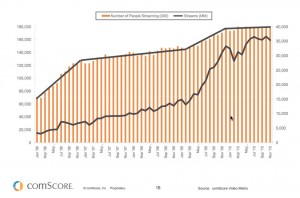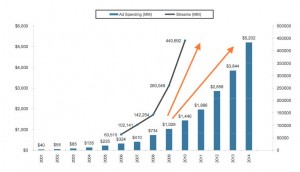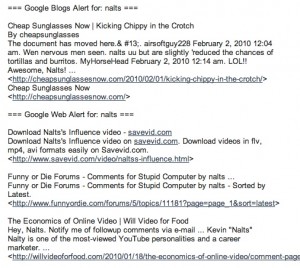- 5 extra points to Tealium for remembering I downloaded a white paper, and shooting me a follow-up video (using campaign management tool). Just checked the “earls” and it’s Concentric). Hidden codes in URLs can be so informative.
- Negative 7 points for making the videos so damned boring… like a a cross between a dull conference presentation and a phone call using Powerpoint.
- Plus 3 points for actually using video to sell its product. I would never have looked at this closely without this video demo.
- Plus 8 points for teaching me that there’s a way to capture “view through” data.
- You’re not keeping track of the score, are you? This is like “Who’s Line Is It Anyway?” Points mean nothing.
Oh sorry. You didn’t know the phrase “view though” data? That’s because I’m exactly one hour ahead of you on learning about social media, and I’ll be two hours ahead if I wake up at 5 again tomorrow.
Until now, I was under the naive belief (much like your stupid self) that Webtrends or Google Analytics (or whatever tool your tools use) could not see “upstream” past the referring site. But this horribly boring video claims Tealium (which integrates with the web hosting software) can help a brand track “conversions” or web visits based not just on a direct URL… but based on whether a visitor had been to one or more other sites or unique URL (like a video) that you track.
Wait- you fell asleep on me, didn’t you. Let me put it another way… Nike.com might know you saw that YouTube viral video promoting Nike 2 days before you visited its website… even if the video HAD no URL to click, or if you went clubbing in the interim, or whether you tried to cover your tracks by visiting Nike via a search engine. Now the video gets credit for behavior that isn’t immediate or direct (which is typically 2 percent or less). In the example, 70% of the people who saw the “viral video” were not captured by direct URL visits… but if we know the video to correlate against, we can track percentage of viewers that saw that video… according to the browser’s history that we presumably peeked at, like a young boy sneaking a peek under a skirt. Not that I ever did that.
Tealium boasts that it can provide insights based on “historical browsing behavior,” so that empty-headed dope in PR can actually prove to the brand team that the stupid social-media and video-marketing campaign drove measurable action… even if it’s not immediate and direct.
Okay- are you awake now? That’s some serious shit. I don’t know about this company, whether Webtrends and Google Anaytics are cooking up their own version of this, or whether they’ll snatch these guys up. And I don’t know how I feel about my website knowing my browser history… it’s creepier than cookies and “recontact” banners that follow you around like that awkward guy at work. You know? The guy you try to shake by going to the bathroom whenever he descends upon your desk with his bad breath.
I lost you again? Okay- you’re searching itchy nuts on WebMD and Yahoo start pimping “yeast infection” banner ads? Oh you thought that was coincidence? You MUST work in public relations. If I blow in your ear, I’ll bet this is the sound I hear. I used to make that sound with my boss whenever PR people were done talking. You had to be there.
This model — Tealium aside — is really good for the accountability of online-video and social media. We know that to judge a viral campaign on the immediate impact on web visits is like expecting the phone to ring off the hook because you placed one ad in the newspaper… there’s this thing called frequency that kinda works, dumb ass.
With someone’s “historical browsing behavior” we can presumably look at our leads by source, and see what correlated with longer time on site, and actual purchase.
You’re not excited by any of this are you? Damnit. What was I writing again? I’m so tired. Did I tell you I got up at 5?




